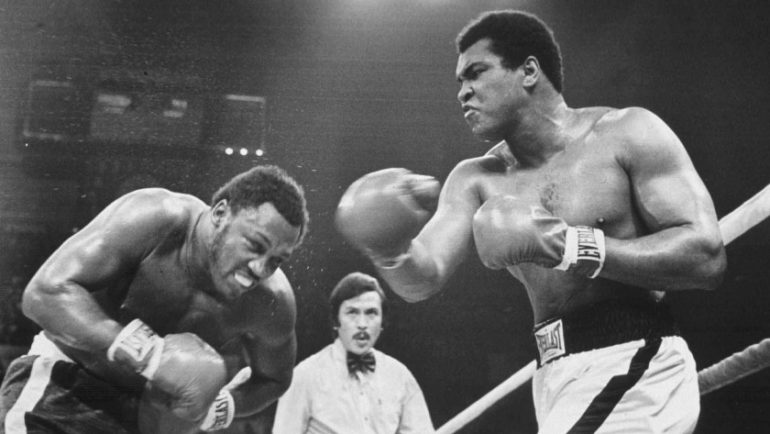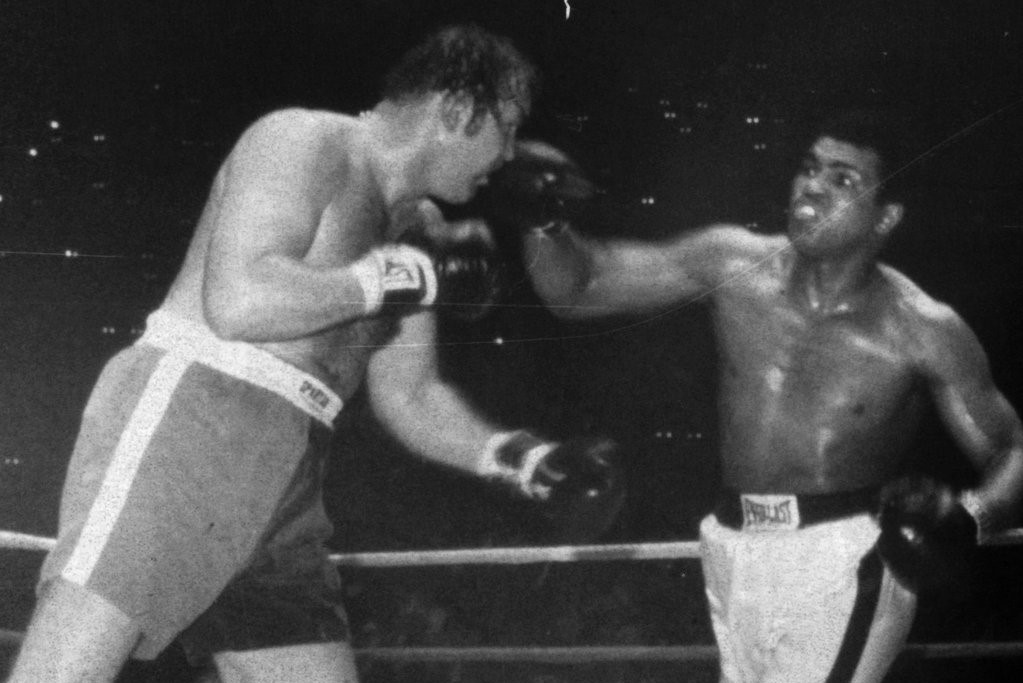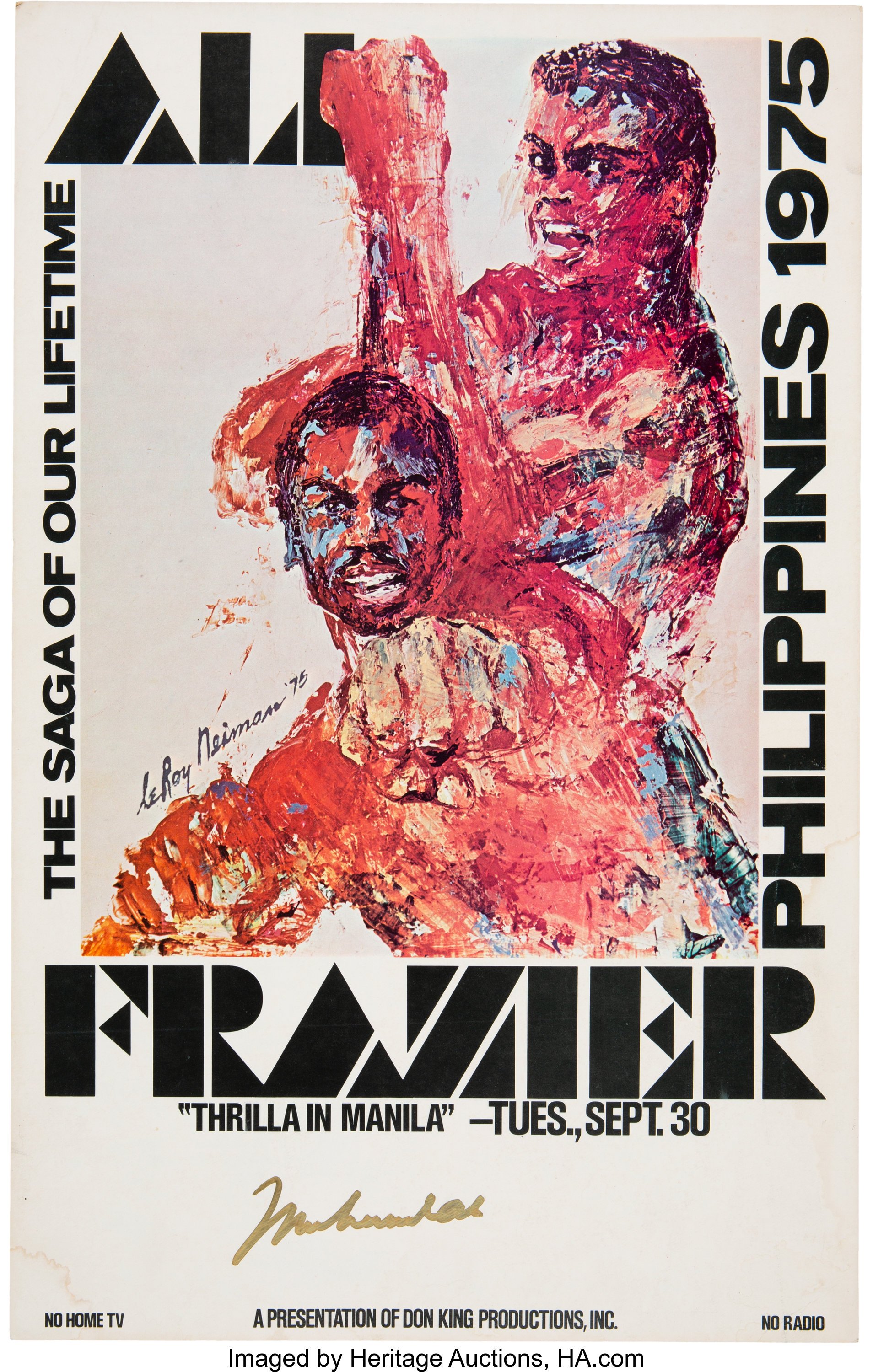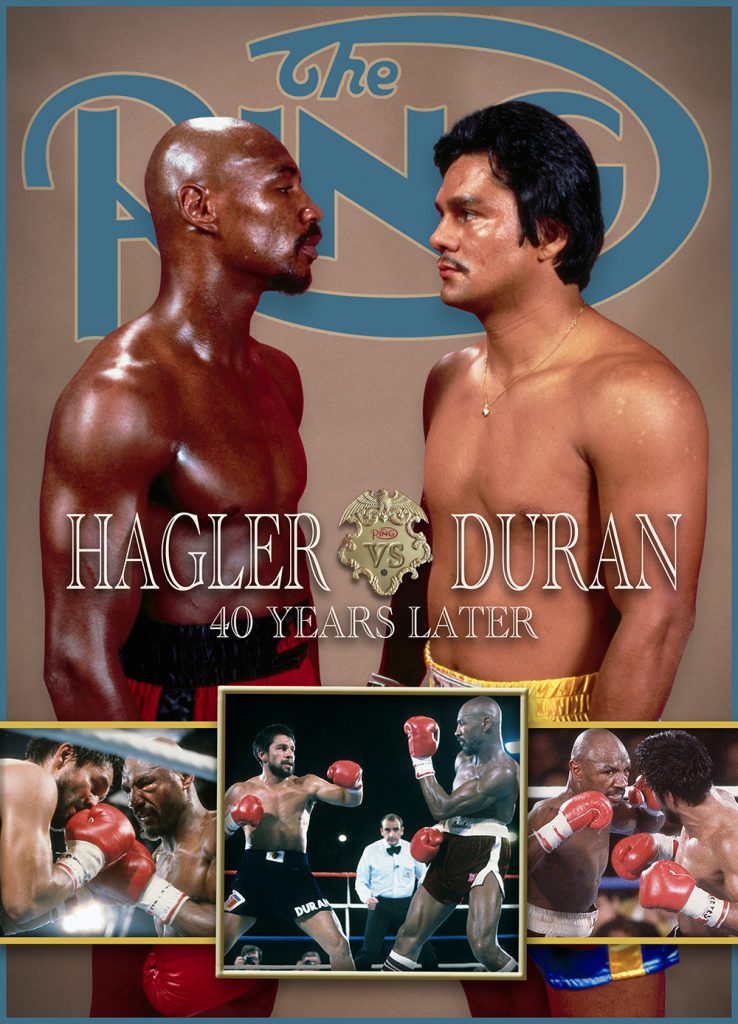Muhammad Ali from 1974 to 1975: A rumbling and thrilling trek toward immortality

Great fighters usually have solid streaks upon which they build their legacies. Sometimes the streaks match their physical and athletic prime. Other times, they find ways to reinvent themselves and summon all their strengths to make an unforgettable statement with extraordinary sequences of successes.
Legends, however, are known for finding ways to reset their careers over and over again, as if they possessed an unlimited supply of personalities hidden within them. Their magic consists in emerging from the magician’s top hat as a completely different animal each time they’re called out to amaze their audiences. Today’s rabbit is tomorrow’s white dove. Today’s butterfly with bee stingers is tomorrow’s rope-a-dope-ing brawler.
For Muhammad Ali, a consummate magician inside and out of the ring, luring his audience and his opponents into his many traps was as much a part of his act as his jab and his uppercuts. The testimony of that unparalleled penchant for reinvention is the fact that he is the only fighter in history to have won The Ring’s Fighter of the Year award on six occasions during a 15-year span.
Incredible feats indeed, boosted by the fact that Ali achieved them using completely different approaches to boxing in almost every one of his years. The distance between the extraordinarily agile Ali of 1963 and the plodding yet still elusive and effective Ali of 1978 could not be greater and the diversity of styles he faced during those years (and his approach in his victories over those opponents) has very few, if any, parallels in boxing history.
One year exemplifies all this and it is the 11-month period between his extraordinary win in Kinshasa, Zaire, and his equally extraordinary victory in Manila. In a world in which champions carefully choose the two or three opponents they’ll face each year with the diligence of a market analyst and the fearful hesitancy a risk-assessment expert, Ali gladly walked into a year-long hail of raining leather, hellish weather and impossible odds to finally convince the few remaining naysayers that “The Greatest” was not, after all, just an empty superlative.
Ali died five years ago, at 74 years of age. The number, in any other situation, would mean nothing. I choose to believe that it magically matches the year of the 20th century in which The Greatest left his most indelible mark in the history books, an 11-month run that grows more and more stunning with each year that passes.
Here’s a short recap of Ali’s most memorable year-long winning streak:
October 30, 1974 – Muhammad Ali TKO 8 George Foreman, Kinshasa, Zaire
After a months-long build-up (including a postponement after George Foreman suffered a cut in training), neither one of the fighters required any introduction before the bout.
After it ended, the fight itself would become the one that would need no introduction. Ever.
Just mentioning its name, the now-fabled “Rumble in the Jungle,” is more than enough to evoke all kinds of memories.

Muhammad Ali (right) on the attack against George Foreman. Photo by AFP/ Getty Images
The facts are well known: A newcomer to the world of boxing promotions, Don King, talked a brutal dictator, Mobutu Sese Seko, into bankrolling a music and boxing extravaganza in the middle of the Congolese jungle (Zaire would later become the Republic of Congo). What followed was a fight that generated a book of its own (Norman Mailer’s “The Fight”), an Oscar-winning documentary (“When We Were Kings”) and countless articles and mentions in popular culture.
The spectacular backdrop and the chain of events leading to the fight were only two reasons why this bout captured the attention of the entire world, in what became one of the most scrutinized sporting events in history. In a fight he was expected to lose against an unbeaten, murderous puncher like Foreman, Ali turned the tables on every incredulous ringsider to beat Foreman in the only stoppage ever administered to a guy who would ultimately fight until his late-40s without ever being stopped again.
That was just the first act of an 11 month-long script with a plot so full of twists and turns as to be worthy of yet another Oscar-winning film.
To wit…
March 24, 1975 – Muhammad Ali TKO 15 Chuck Wepner, Richfield, Ohio
The logical move after a tough fight is to pair the winner with a “soft touch,” an easy opponent, to score a self-assuring victory and maintain confidence. The prospects of a punishing fight or a humiliating moment are to be avoided at all costs.
Someone should have faxed that memo to Chuck Wepner before the bout.
Fortunately no one did. And when we say “fortunate,” we may as well emphasize “fortune.” As in a $1.7 billion (with a “b”) US dollar fortune.
That is the combined amount of money produced by the “Rocky” movie franchise worldwide since the release of the homonymous motion picture in 1976, the most celebrated pugilism-themed photoplay in history and one that has arguably produced more money than the entire career of Muhammad Ali and all of his opponents combined.

CLEVELAND – MARCH 24,1975: Muhammad Ali (right) connects with a right hand against Chuck Wepner during their fight at Richfield Coliseum on March 24,1975, in Cleveland,Ohio. Ali won the WBA and WBC heavyweight titles by a TKO 15. (Photo by: The Ring Magazine/Getty Images)
The facts here are as well-known as in any of the other episodes of this almost year-long magical novel: A young and broke Sylvester Stallone watched the fight on closed-circuit and after seeing the hopeless, sagging, bleeding, balding and bulging Wepner knock the legendary and heavily-favored Ali down in Round 9, concocted the rags-to-riches story of the awkward Italian kid who challenged the heavyweight champion on the world on short notice and comes heroically close to scoring an upset for the ages and which became the basis of Stallone’s Academy award-winning opus.
The Ali-Wepner fight itself was no Rocky affair. It wasn’t particularly close, entertaining or disputed. But every time one is inspired to create a multi-billion-dollar movie franchise, that effort becomes a most memorable one nonetheless.
May 16, 1975 – Muhammad Ali TKO 11 Ron Lyle, Las Vegas, Nevada
It is always a good idea to look at what Ali’s opponents did to some of their foes in other fights to appreciate the genius of Ali’s ring savvy and physical prowess.
Ali vs. Ron Lyle is no exception.
A former convict who was often furloughed from prison to participate in prizefights, Lyle was one of the most spectacular boxing specimens ever to set foot inside a ring. A man of brutal strength, with a chiseled physical frame and a razor-sharp look in his eyes. His fight against Earnie Shavers, which took place immediately after Ali-Lyle, is still, today, a study in sheer brutality that can only be found in film, in either war or demolition-related footage. A mutually destructive affair disguised as a sporting event.
Facing the wrath of this phenomenal threat of a man, Ali displayed some of his best moves and turned back time to duck, bob and weave his way out of danger while administering a progressive and demoralizing beating on Lyle, who surrendered in the 11th round of a fight that could have earned him the “Fighter of the Year” award on its own merit.
However the year was young indeed.
June 30, 1975 – Muhammad Ali W15 Joe Bugner, Kuala Lumpur, Malaysia
Even in the “miles traveled” category, this year should be emblematic for Ali. But hey, what’s a trip to an exotic destination if you don’t get to punch someone in the head for money too, huh?
Only 45 days after his 11-round clash with Lyle (a period of time in which any other mere mortal would have to sleep through just to recover from that effort), Ali traveled to Malaysia to face Hungarian-born, Australian transplant and British subject Joe Bugner, in a rematch of their 1973 bout (also won by Ali on points) but with the title at stake this time.
The humid, sticky heat of the Malaysian capital was an issue from the beginning but, in hindsight, it was probably a much-needed period of acclimation for Ali’s next bout. Ali put the pressure on Bugner early on and while Bugner rallied in the 10th to put the heat back on Ali for a minute, the champ recovered to put the challenger in trouble in the 13th and then cruised to another win, in what became the only fight in this entire period Ali didn’t win by stoppage.
But there was quite a memorable stoppage to look forward to in the near future.
October 1, 1975 – Muhammad Ali TKO 14 Joe Frazier III, Manila, The Philippines
Breathing fire and walking on embers is not actually part of the magician’s bag of tricks but perhaps Ali had much more than a magic touch on his side in the fabled “Thrilla in Manila.”
As in his 1964 against-all-odds win over Sonny Liston, Ali pulled off this extraordinary trick with the help of his sidekick, mentor and trainer Angelo Dundee, perhaps the one chief second with the largest bag of tricks in boxing history. Dundee was old enough to have firsthand knowledge of the “wise men” era of boxing’s dirty tricks and he had grown wise enough to use the ones that did not require the dishonesty and treachery that could affect the legacy of his fighter.

Muhammad Ali vs. Joe Frazier III. Art by Leroy Neiman
It took all of Dundee’s knowledge to keep Ali competitive though this absolutely brutal fight under 110-degree heat in the Philippines and even more knowledge and street-smarts to push his fighter to the winner’s circle. With the fight on the line, an all-time-best boxing trilogy coming to an end and his fighter exhausted, Dundee urged Ali to stand up in his corner at the beginning of the 15th and final round, just to show Frazier that there was going to be a 15th round and that Frazier, as exhausted as he was (and with his right eye closed shut by Ali’s punches to go with his already almost-blind left eye), would have to go through it if he wanted the fight to go to the scorecards.
Frazier was not allowed to come out of his corner by his trainer Eddie Futch and the rest is history. But the fact that Ali was able to put his 33-year old body through such devastating punishment to cap off a rolling year pretty much defined by his exposure to devastating punishment is more than enough to answer every question about Ali’s measure of greatness.
“It was like death. Closest thing to dying that I know of,” said Ali after the fight.
It was, after all was said and done, the final seal on his passport to immortality.
SUBSCRIBE NOW (CLICK HERE - JUST $1.99 PER MONTH) TO READ THE LATEST ISSUE















